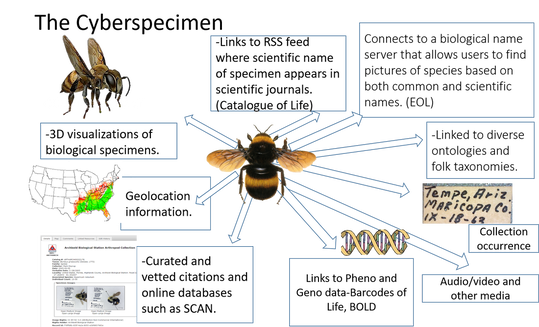
Libraries of Life Project Update/Report 10/3/2022
by Anne Basham
Libraries of Life was initially developed and released in January 2016 in collaboration with Arizona State University/ExplorMor Labs, iDigBio, and Florida State University. In its debut the app linked educational content with specimens and their data providing learners with an interactive experience with natural history collections.
The app was used with some 2,000+ museum and conference visitors at numerous outreach events held nationwide with 6k app downloads.
-The Libraries of Life website which is also accessed from the app has had 35,000 page views and 25,000 visitors since 2017.
-The U.S. and Canada were the top two users of the app followed by Mexico at number three.
While proven as an effective outreach tool there remains questions as to how might the app be used beyond the initial engagement and fascination of the technology. There is currently much research focused on how might AR be used to enhance learning such as memorization, spatial-based learning, etc. Initial observations of adult learners in a GED program showed that students preferred observing specimens via the app rather than a microscope. This was especially true for those who were unfamiliar with or even uncomfortable in using a microscope.
Potential research questions yet to explore
Just in the past five years of this project, the use of photogrammetry and other new imaging technologies have been widely adopted and is now in wide use by many institutions. Science is only now realizing the benefits of 3D construction in being able to see traits and characters in a species or even as a means to assess whole environments and habitats via 3D imaging and scanning in the field.
As the 3D library of natural history specimens grows, the Libraries of Life project and others are asking how 3D data might be given unique identifiers, distributed, shared, and integrated for use in the classroom and other uses and applications. How might the resulting data be used to enhance not only engagement but also as a tool of learning?
More specific to learning are these questions.
•Do objects need to be physical objects to promote meaningful learning and engagement with collections?
•What different learning impacts and outcomes might there be between virtual over physical objects?
•What role and impact might new immersive technologies have in distance education?
The Extended Cyberspecimen
New immersive technologies are making it possible for us to expand and build on the concept of the extended specimen. All data has the potential of being represented as augmented superimposed layers linked with a tangible specimen. It is a concept limited only by cloud space or how much data can be downloaded into one's device.
Technical challenges for the end-user
As with any technology-based learning tool the experience of the end-user is largely dependent on the type of device they have access to along with access to the Internet. Some devices may have limited storage space for in-device caching. Other problems may be associated with general knowledge in how to download apps, scanning QR codes, etc. For use in the classroom certain criteria and conditions have to be met in order for learning to happen. In a classroom that consists of mainly high school students doing a simple QR code scavenger hunt can even be a challenge when students are using outdated mobile devices, etc. 3D models while valuable for scientific observation, can slow down engagement if download times are too slow due to slow bandwidth, low memory or file sizes that are too large.
Challenges for the developer
Challenges we encountered in the development of the Libraries of Life app have largely been related to making decisions as to which technology that will provide both convenience and ease of maintenance. WebAR technology resolves the issues related to being able to update content, but the trade off is often lower quality and slower tracking and/or anchoring of objects in the AR scene. Cloud-based options will most likely be our next approach to ensure both quality and convenience of vetting and curating content quickly. Device-based experiences however offer greater accessibility to content without the dependence of a quality Internet connection. This was especially useful when using the app at conferences and trade shows. Device-based experiences ensure stability and accessibility to the content regardless of Internet quality.
Where to from here?
There are many research-based questions still to be explored and answered.
•Do objects need to be physical objects to promote meaningful learning and engagement with collections?
•What different learning impacts and outcomes might there be between virtual over physical objects?
•What role and impact might new immersive technologies have in memorization and spatial-based learning?
•Can virtual specimens surpass that of the original specimen?
Ultimately to answer these questions there needs to be more options and entry points in the use of the technology for the purposes of education and research.
In Conclusion
In retrospect, one can easily find themselves spending too much time on the technology trying different modes of delivery, resources and time for troubleshooting, etc. All of this can leave little time to assess its impact as a learning tool. Now with so much 3D digitization being generated by multiple institutions, now is the time to rethink what problems the next iteration of the Libraries of Life app might solve and what features it might offer that will connect science with diverse learners in new and exciting ways. Our next step is to look at the pros and cons as to what the technology currently offers and through new partnerships and collaborations take it to the next level.
References
https://www.researchgate.net/profile/Antigoni-Parmaxi/publication/343829243_Augmented_reality_in_language_learning_A_state-of-the-art_review_of_2014-2019/links/60c6f874299bf1949f57e9cf/Augmented-reality-in-language-learning-A-state-of-the-art-review-of-2014-2019.pdf
Seeking Partners and Collaborators
